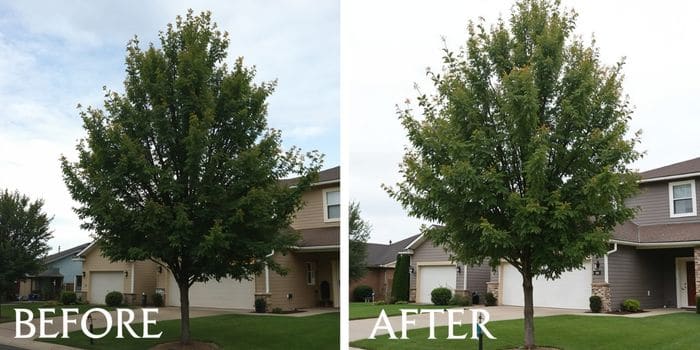Save Money and Reduce Stress: The Benefits of Regular Tree Trimming
Maintaining a well-kept landscape is more than just an aesthetic choice; it’s a crucial investment in your property’s health and value. Regular tree trimming not only enhances the beauty of your home but also offers significant financial and emotional advantages. With proper tree care practices, homeowners and property managers can enjoy the benefits of tree trimming and ensure their outdoor spaces remain tranquil sanctuaries. From preventing costly damage to fostering robust tree growth, understanding the benefits of tree care transforms maintenance into a cost-effective landscaping strategy. Join us as we explore essential Kap Tree landscaping advice that promises stress-free trees and empowers you with homeowner tree care tips to keep your property thriving.
Financial Benefits of Tree Trimming
Regular tree trimming isn’t just about aesthetics; it’s a wise financial decision. Let’s explore how this essential maintenance can lead to significant savings and cost-effective landscaping strategies.
Tree Trimming Savings Explained
Tree trimming is an investment that pays dividends in the long run. By maintaining your trees regularly, you can avoid costly emergency services and potential property damage.
Proper trimming reduces the risk of falling branches during storms, which can cause expensive damage to your home, vehicles, or neighboring properties. This preventive measure can save you thousands in repair costs and insurance premiums.
Southwest Ranches Tree trimming by Kap Tree Service also promotes healthier growth, reducing the need for expensive tree removal services in the future. Healthy trees are more resistant to pests and diseases, saving you money on treatments and replacements.
Moreover, well-maintained trees can increase your property value. According to real estate experts, mature, properly cared-for trees can add up to 10% to your home’s value, making tree trimming a wise financial investment.
Cost-Effective Landscaping Strategies
Incorporating regular tree trimming into your landscaping routine can lead to significant cost savings over time. Here are some strategies to maximize your investment:
-
Schedule annual inspections to catch potential issues early.
-
Trim during the dormant season for most tree species to minimize stress and promote healthy growth.
-
Invest in proper tools or hire professionals for complex jobs to ensure efficiency and safety.
By following these strategies, you can:
-
Reduce the frequency of major trimmings
-
Minimize the risk of property damage
-
Decrease the likelihood of tree-related emergencies
A well-planned tree care routine not only saves money but also enhances the overall beauty and health of your landscape. Remember, prevention is always more cost-effective than reactive measures.
Stress Reduction Through Tree Care
Believe it or not, maintaining your trees can significantly reduce stress levels. Let’s explore how proper tree care can contribute to a more peaceful environment and provide homeowners with valuable relaxation tips.
Stress-Free Trees for Peace of Mind
Well-maintained trees contribute to a serene and worry-free outdoor environment. By ensuring your trees are healthy and properly trimmed, you can eliminate everyday stressors associated with neglected landscapes.
Regular trimming removes dead or weakened branches, reducing the anxiety of potential falling limbs during storms or high winds. This proactive approach provides peace of mind, especially during severe weather events.
Neat, trimmed trees also create a more organized and aesthetically pleasing landscape. Studies have shown that well-maintained green spaces can significantly reduce stress levels and improve overall mental well-being.
Moreover, healthy trees act as natural sound barriers, reducing noise pollution from nearby roads or neighbors. This can create a more tranquil home environment, contributing to reduced stress and improved relaxation.
Homeowner Tree Tips for Relaxation
Incorporating tree care into your routine can be a therapeutic and rewarding experience. Here are some tips to make tree maintenance a stress-reducing activity:
-
Begin with simple tasks, such as removing small dead branches or light pruning.
-
Use tree care as an opportunity for mindfulness, focusing on the present moment and the task at hand.
-
Engage with nature by observing wildlife that your trees attract.
Regular tree care can also serve as a form of gentle exercise, promoting both physical health and mental well-being. Maintaining a beautiful landscape can boost your mood and self-esteem.
Remember, if tree care feels overwhelming, professional services can handle the work while you enjoy the benefits of a well-maintained landscape. The goal is to create a stress-free environment that allows you to enjoy yourself truly.
Effective Tree Maintenance Practices
Implementing effective tree maintenance practices is crucial for the long-term health and beauty of your landscape. Let’s explore the year-round benefits of tree care and some expert landscaping advice for optimal growth.
Benefits of Tree Care Year-Round
Tree care isn’t a one-time task; it’s a year-round commitment that yields numerous benefits. By maintaining your trees throughout the seasons, you ensure their health, longevity, and beauty.
Spring maintenance focuses on assessing winter damage and preparing trees for the growing season. This includes light pruning and fertilization to promote robust growth.
Summer care involves monitoring for pests and diseases, as well as ensuring adequate watering during periods of drought. Proper hydration is essential for maintaining tree health and enhancing stress resistance.
Fall is ideal for major pruning tasks as trees enter dormancy. It’s also the perfect time to plant new trees, allowing them to establish strong root systems before the next growing season.
Winter maintenance includes protecting trees from harsh conditions and planning for the upcoming year. Regular inspections during this time can identify potential issues early.
Landscaping Advice for Optimal Growth
To ensure your trees thrive and contribute positively to your landscape, consider these expert tips:
-
Select native species that are adapted to your local climate for easier maintenance and improved resilience.
-
Plant trees in suitable locations, taking into account their mature size and sunlight requirements.
-
Implement proper watering techniques, focusing on deep, infrequent watering to encourage strong root growth.
Mulching is another crucial aspect of tree care:
-
Apply a few inches or so, depending on your preference, just to cover the area at the base of the trees.
-
Keep mulch away from the trunk to prevent moisture buildup and potential disease.
-
Refresh mulch annually to maintain its benefits.
Regular soil testing can guide your fertilization efforts, ensuring trees receive the proper nutrients for optimal growth. Remember, over-fertilization can be as harmful as under-fertilization.
By following these practices, you’ll create a thriving, beautiful landscape that enhances your property’s value and provides numerous environmental benefits.


